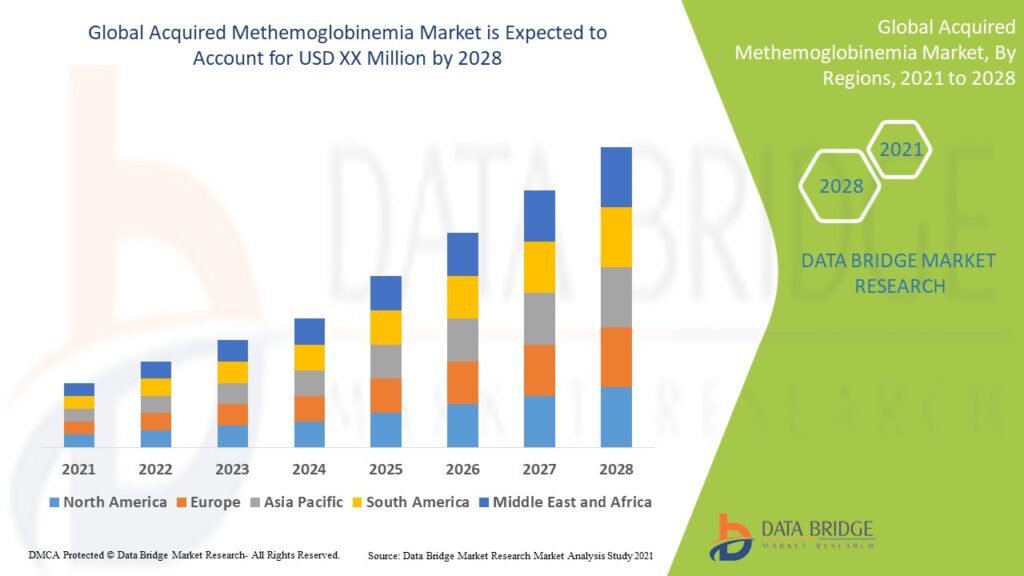Introduction of Acquired Methemoglobinemia Market
Acquired Methemoglobinemia (AM) is a rare but serious blood disorder caused by exposure to certain chemicals or drugs that oxidize hemoglobin, reducing its oxygen-carrying capacity. Unlike congenital forms, acquired methemoglobinemia is often preventable and treatable, making timely diagnosis and intervention critical. The rarity of the condition, coupled with its potentially life-threatening nature, has created a niche but growing market for diagnostic tools, treatments, and research investments. This article delves into the dynamics of the Acquired Methemoglobinemia market, examining its key drivers, challenges, competitive landscape, and future potential.
Understanding Acquired Methemoglobinemia
Methemoglobinemia occurs when the iron in hemoglobin is oxidized from the ferrous (Fe2+) to the ferric (Fe3+) state, which impairs its ability to bind and transport oxygen. This leads to hypoxia despite normal oxygen saturation levels. In acquired methemoglobinemia, the condition arises due to exposure to oxidizing agents such as benzocaine, nitrates, dapsone, and certain aniline dyes.
Symptoms can range from cyanosis and fatigue to severe neurological deficits or death in extreme cases. Diagnosis involves blood tests showing elevated methemoglobin levels, and treatment typically includes administration of methylene blue, a reducing agent that restores normal hemoglobin function.
Market Overview
The market for acquired methemoglobinemia is relatively small due to the condition’s rarity. However, increased awareness, better diagnostic tools, and advancements in toxicology and emergency medicine are contributing to steady growth.
Key segments within this market include:
-
Pharmaceuticals: Methylene blue remains the cornerstone of treatment. However, research into alternatives for patients with G6PD deficiency, for whom methylene blue is contraindicated, is ongoing.
-
Diagnostics: Point-of-care testing devices and advanced blood gas analyzers are vital for rapid diagnosis.
-
Hospitals and Emergency Services: These are the primary settings where treatment is administered, particularly in acute care and poison control centers.
Market Drivers
-
Increased Awareness and Diagnosis
Historically underdiagnosed, acquired methemoglobinemia is now recognized more frequently due to improved clinical awareness and access to advanced diagnostic tools. Medical training programs and continuing education on drug-induced blood disorders have helped in early identification. -
Rise in Drug-Induced Cases
The over-the-counter use of topical anesthetics and exposure to industrial chemicals has contributed to a rise in AM cases, particularly in developing regions where regulatory oversight may be limited. -
Advancements in Diagnostic Technology
Modern co-oximeters and multi-parameter blood analyzers now allow for faster and more accurate detection of methemoglobin levels, leading to timely and effective treatment interventions. -
Research and Development Investments
Pharmaceutical companies and research institutions are exploring alternative therapies for patients who cannot tolerate methylene blue, such as ascorbic acid and hyperbaric oxygen therapy.
Challenges in the Market
Despite the opportunities, several challenges hinder rapid market growth:
-
Rarity of the Condition: The limited patient population restricts large-scale investment from pharmaceutical giants.
-
Limited Therapeutic Options: Methylene blue remains the only widely accepted first-line treatment, and alternatives are still in the experimental phase.
-
Regulatory Hurdles: Developing and approving new drugs or diagnostic tools for a rare condition can be costly and time-consuming due to strict regulatory frameworks.
-
Underreporting and Misdiagnosis: Many cases of AM go unreported, especially in rural or under-resourced healthcare settings, leading to a perceived low prevalence.
Regional Market Insights
-
North America: Holds a significant share of the market due to advanced healthcare infrastructure, widespread availability of diagnostic tools, and higher awareness levels. The U.S. sees occasional spikes in cases due to topical anesthetic use.
-
Europe: Similar to North America in terms of diagnostics and treatment availability, with a strong emphasis on regulatory oversight.
-
Asia-Pacific: A rapidly emerging market due to increasing industrialization and a growing middle class with access to over-the-counter medications. However, lack of awareness and diagnostic tools remains a concern.
-
Latin America and Africa: These regions face the greatest challenges in terms of diagnosis and treatment due to limited healthcare access and lower awareness levels.
Competitive Landscape
The acquired methemoglobinemia treatment market features a mix of pharmaceutical manufacturers, diagnostic device producers, and emergency healthcare providers. Key players include:
-
Provepharm Life Solutions: Known for developing stabilized methylene blue products.
-
Siemens Healthineers and Abbott: Leaders in diagnostic technologies, including co-oximetry devices.
-
Various hospital and poison control networks: Often involved in frontline treatment and reporting of AM cases.
Collaborations between academic institutions and pharmaceutical companies are also increasing, aimed at developing safer, more effective therapies and improving early detection.
Future Outlook
The future of the acquired methemoglobinemia market hinges on three primary factors:
-
Innovation in Treatment: Development of new therapies, especially for G6PD-deficient patients, could significantly alter the treatment paradigm and expand the market.
-
Improved Surveillance and Reporting: Establishing national and international registries can help track incidence rates more accurately, guiding both clinical and commercial strategies.
-
Public and Professional Education: Enhanced education about the dangers of over-the-counter topical anesthetics and industrial chemicals can reduce incidence and lead to earlier intervention.
As awareness grows and technology evolves, the acquired methemoglobinemia market is expected to witness modest but steady growth, especially in emerging markets where regulatory reforms and healthcare improvements are accelerating.
Conclusion
Although acquired methemoglobinemia remains a rare condition, its clinical impact. The critical nature of timely treatment present both a challenge and an opportunity for the healthcare industry. Continued advancements in diagnostics, therapeutic development, and professional education will be key to unlocking the potential of this niche but vital market segment. With the right investments and policy support, the acquired methemoglobinemia market is poised for gradual expansion in the coming years.
Get more Details
https://www.databridgemarketresearch.com/reports/global-acquired-methemoglobinemia-market






